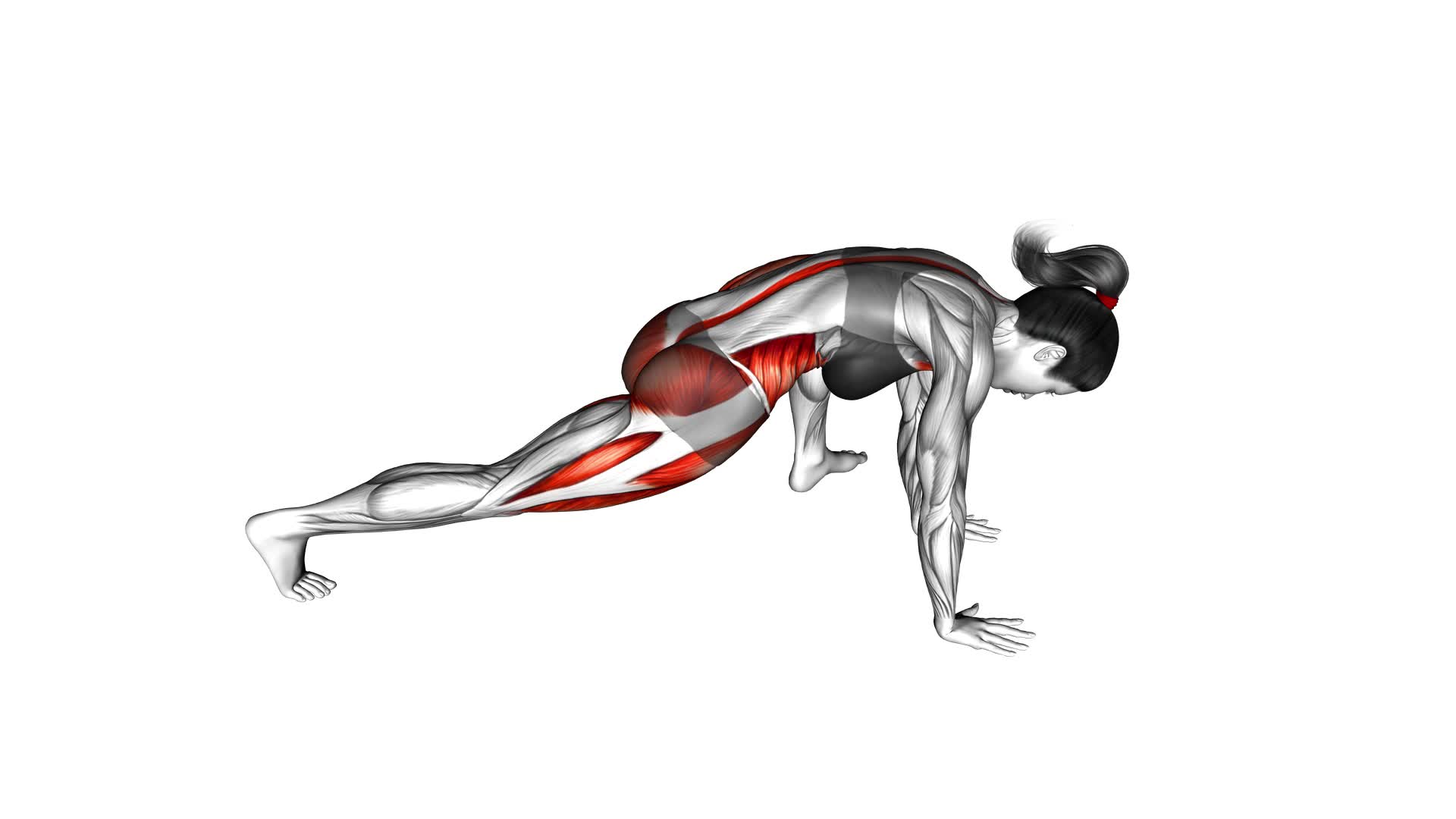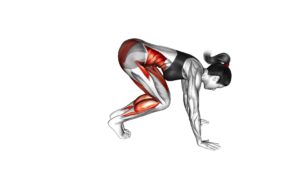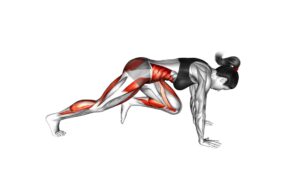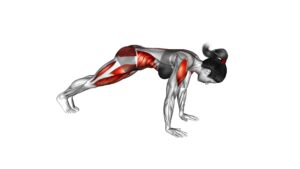Mountain Climber Lunge (female) – Video Exercise Guide & Tips

Are you looking for an effective lower body exercise? Look no further than the Mountain Climber Lunge.
Watch This Exercise Video
This versatile move targets your glutes, quads, and core all in one go. In this video exercise guide, we'll show you the proper form and technique, as well as modifications for beginners and advanced variations for experienced athletes.
Avoid common mistakes and get the most out of your workout with these helpful tips.
Let's get started!
Key Takeaways
- The Mountain Climber Lunge targets the glutes, quads, and core.
- It increases flexibility in the legs, hips, and lower back.
- The exercise provides cardiovascular benefits and improves endurance.
- It can be modified for beginners and advanced variations are available for experienced athletes.
Benefits of the Mountain Climber Lunge
To understand the benefits of the Mountain Climber Lunge, you need to know that it's a compound exercise that targets multiple muscle groups simultaneously. This exercise isn't only effective for building strength, but it also offers various other benefits.
One of the key benefits is that it helps in increasing flexibility. The dynamic movement of the Mountain Climber Lunge stretches the muscles of your legs, hips, and lower back, promoting greater range of motion in these areas. This can be particularly beneficial for athletes or individuals who want to improve their overall flexibility.
Additionally, the Mountain Climber Lunge provides cardiovascular benefits. The combination of the lunging motion and the climbing movement engages your leg muscles and elevates your heart rate. This helps to improve your cardiovascular endurance and burns calories, making it an effective exercise for weight loss and overall cardiovascular health.
Incorporating the Mountain Climber Lunge into your workout routine can help you achieve a well-rounded fitness regimen. Not only does it target multiple muscle groups, but it also offers the benefits of increased flexibility and improved cardiovascular health.
Proper Form and Technique
Start by positioning yourself in a lunge stance with one foot forward and the other foot extended back behind you. Make sure your feet are hip-width apart and your toes are pointing forward. Keep your back straight and engage your core muscles.
To perform the mountain climber lunge with proper form and technique, begin by bending your front knee and lowering your back knee towards the ground. As you do this, make sure to keep your front knee directly above your ankle to avoid any strain or injury.
Next, push through your front heel and lift your back knee off the ground, bringing it forward towards your chest. Alternate between your left and right leg, mimicking the motion of climbing a mountain. Remember to keep your movements controlled and controlled.
One common mistake to avoid is allowing your front knee to collapse inward. This can put unnecessary stress on your knee joint. Instead, focus on keeping your knee aligned with your ankle throughout the exercise.
The mountain climber lunge targets several muscle groups, including your quadriceps, hamstrings, glutes, and core. By performing this exercise correctly, you can effectively strengthen and tone these areas.
Remember to start with a weight that challenges you but allows you to maintain proper form. As you become more comfortable and stronger, you can increase the intensity by adding weights or increasing the speed of your movements.
Modifications for Beginners
To modify the mountain climber lunge for beginners, you can begin by performing the exercise without adding weights. This will help you focus on mastering the movement and building strength before adding any extra resistance.
Here are some additional modifications for novices:
- Start with a shorter range of motion: Instead of bringing your front knee all the way down to the ground, only lower it halfway. This will help you maintain balance and stability as you work on your form.
- Slow down the pace: Instead of performing the exercise at a fast and dynamic speed, try slowing it down. This will allow you to focus on engaging the correct muscles and maintaining proper alignment throughout the movement.
By starting with these modifications, you'll be able to gradually progress and build up your strength and stability.
Once you feel comfortable and confident with these beginner modifications, you can move on to the advanced variations for experienced athletes.
In the subsequent section, we'll explore advanced variations of the mountain climber lunge that will challenge your strength, flexibility, and endurance. These variations will take your workout to the next level and help you achieve even greater results.
Advanced Variations for Experienced Athletes
Now that you've mastered the basic mountain climber lunge, it's time to take your workout to the next level with these challenging modifications for pros.
These advanced variations are designed for experienced athletes who are looking to push their limits and enhance their strength, agility, and endurance.
Get ready to try next level athlete variations and advanced techniques that will challenge your body in new and exciting ways.
Challenging Modifications for Pros
Challenge yourself with advanced variations of the Mountain Climber Lunge to push your limits as an experienced athlete. These advanced modifications will take your training to the next level and help you achieve even greater results.
Here are two challenging modifications you can try:
- Explosive Mountain Climber Lunge: Perform the standard mountain climber lunge, but instead of alternating legs, explode off the ground and switch legs in mid-air. This explosive movement will increase your power and agility, giving you a more intense workout.
- Weighted Mountain Climber Lunge: Hold dumbbells or a weighted vest while performing the mountain climber lunge. The added resistance will engage your muscles even more, increasing the difficulty and helping you build strength and endurance.
These advanced training techniques will test your athleticism and determination. Push yourself to the limit and reap the rewards of a stronger, fitter body.
Next Level Athlete Variations
Take your athletic performance to the next level with advanced variations of the Mountain Climber Lunge. If you're looking to push your fitness to the next level, incorporating advanced training techniques into your workout routine can help you achieve your goals.
These next level athlete variations of the Mountain Climber Lunge are designed for experienced athletes who are looking for a challenge. One variation is the weighted Mountain Climber Lunge, where you hold dumbbells or a kettlebell in each hand while performing the exercise. This adds resistance and increases the intensity of the movement.
Another advanced variation is the plyometric Mountain Climber Lunge, where you explosively jump and switch legs in mid-air. This variation helps improve power and agility.
Advanced Techniques for Experts
If you're an experienced athlete looking to take your fitness to new heights, try incorporating advanced variations of the Mountain Climber Lunge into your workout routine. These advanced modifications will challenge your body in new ways and push you beyond your limits.
Here are some advanced training techniques to try:
- Explosive Mountain Climber Lunge: Instead of performing the exercise at a steady pace, explode up from the lunge position and switch legs in mid-air. This explosive movement will engage your fast-twitch muscle fibers and increase your power and agility.
- Weighted Mountain Climber Lunge: Hold a pair of dumbbells or a weighted vest while performing the exercise. The added resistance will help build strength and increase the intensity of the workout.
Common Mistakes to Avoid
To avoid common mistakes while performing the Mountain Climber Lunge exercise, make sure you maintain proper form and engage your core throughout the movement.
One common mistake to avoid is letting your shoulders round forward. This can lead to poor posture and put unnecessary strain on your upper body. To improve your performance, keep your shoulders back and down, and imagine squeezing your shoulder blades together.
Another mistake to watch out for is allowing your knees to extend past your toes during the lunge. This can place excessive pressure on your knees and increase the risk of injury. Instead, focus on keeping your knees in line with your toes and your weight evenly distributed through your feet.
Additionally, avoid rushing through the exercise and sacrificing proper form for speed. Take your time and focus on maintaining control and stability throughout the movement.
Tips for Maximizing Your Workout
To maximize your workout, it's crucial to focus on proper form techniques. This means maintaining good posture, engaging your core, and using the correct range of motion for each exercise.
Additionally, targeting specific muscle groups is key for achieving your fitness goals. Be sure to incorporate exercises that work the areas you want to strengthen or tone.
Lastly, don't be afraid to increase the intensity levels of your workouts over time. This can be done by adding weights, increasing reps or sets, or trying more challenging variations of exercises.
Proper Form Techniques
Maximize your workout by focusing on proper form techniques while performing the Mountain Climber Lunge exercise. To ensure you get the most out of this exercise, avoid these common mistakes and follow these tips:
- Maintain proper alignment: Keep your back straight and core engaged throughout the movement to protect your spine and maximize the effectiveness of the exercise.
- Control your movements: Avoid rushing through the exercise. Instead, perform the mountain climber lunge in a slow and controlled manner to engage your muscles and improve stability.
- This will allow you to fully activate your glutes, quads, and hamstrings, resulting in a more intense workout.
- It will also prevent you from relying too much on momentum and increase the overall difficulty of the exercise.
Targeting Muscle Groups
To target specific muscle groups and maximize your workout, focus on proper form techniques while performing the Mountain Climber Lunge exercise.
This exercise primarily activates the muscles in your lower body, including your quadriceps, hamstrings, glutes, and calves. As you lunge forward, your quadriceps engage to extend your knee, while your glutes and hamstrings work to control the movement. The Mountain Climber Lunge also requires core stability, activating your abdominal muscles and obliques.
To further enhance muscle activation, you can incorporate variations to target different muscle groups. For example, adding a twist at the end of each lunge can engage your obliques more intensely. Additionally, you can progress your training by increasing the weight or reps, or by adding resistance bands or weights to challenge your muscles further.
Remember to always maintain proper form and consult with a fitness professional to ensure correct technique and progression.
Increasing Intensity Levels
To increase the intensity of your workout and achieve maximum results, incorporate these tips for maximizing your Mountain Climber Lunge exercise:
- Progression Levels:
- Increase the number of reps: Start with a lower number of reps and gradually increase as you get stronger.
- Speed it up: Perform the exercise at a faster pace to challenge your cardiovascular endurance and burn more calories.
- Workout Modifications:
- Add weights: Hold dumbbells or wear ankle weights to increase resistance and build strength in your lower body.
- Elevate your feet: Place your feet on an elevated surface, such as a step or bench, to intensify the exercise and target your glutes and hamstrings.
By incorporating these progression levels and workout modifications, you can take your Mountain Climber Lunge exercise to the next level.
Remember to listen to your body and progress at a pace that's challenging yet manageable. Push yourself, but also prioritize proper form and technique to avoid injury and maximize your results.
Frequently Asked Questions
How Many Calories Does the Mountain Climber Lunge Burn?
The mountain climber lunge is a great exercise for burning calories and improving lower body strength. While the exact number of calories burned during this exercise may vary depending on factors like intensity and duration, it's generally considered a high-intensity exercise that can help you shed those extra calories.
Additionally, the mountain climber lunge offers various modifications to suit different fitness levels and targets muscles in the legs, core, and glutes for a well-rounded workout.
Can the Mountain Climber Lunge Help Improve Balance and Coordination?
The mountain climber lunge can definitely help improve your balance and coordination. By performing this exercise, you're engaging multiple muscle groups and challenging your stability.
This movement requires you to shift your weight and maintain control, which can enhance your agility over time.
The benefits of the mountain climber lunge go beyond just burning calories; it also helps you develop better control over your body and improve your overall athletic performance.
Are There Any Specific Muscles That the Mountain Climber Lunge Targets?
The mountain climber lunge targets several muscle groups in your body. It primarily works your quadriceps, hamstrings, glutes, and calves.
This exercise also engages your core muscles, including your abs and obliques.
By incorporating variations and modifications, you can increase the intensity and target specific muscle groups even more. For example, adding a twist at the top of the lunge can engage your obliques further.
Don't forget to maintain proper form throughout the exercise to maximize your results.
Can the Mountain Climber Lunge Be Incorporated Into a Circuit Training Routine?
Yes, the mountain climber lunge can definitely be incorporated into a circuit training routine. It's a great exercise that targets multiple muscle groups and provides a cardiovascular challenge.
To modify it for a circuit, you can perform the lunge quickly and move smoothly into the next exercise. Circuit training is an effective way to maximize your workout time and the compound nature of the mountain climber lunge adds to the benefits of this type of training.
Is It Necessary to Warm up Before Performing the Mountain Climber Lunge?
Before performing the mountain climber lunge, it's important to warm up. Warming up has many benefits, such as increasing blood flow to your muscles and joints, improving flexibility, and reducing the risk of injury.
If you don't have time for a full warm up, you can do some dynamic stretches or light cardio exercises to get your heart rate up.
Conclusion
In conclusion, the mountain climber lunge is a dynamic exercise that offers numerous benefits for both beginners and experienced athletes. By focusing on proper form and technique, you can effectively target your lower body muscles while also engaging your core and improving your balance.
Remember to start with modifications if you're new to this exercise and gradually progress to advanced variations as you become more comfortable. Avoid common mistakes and follow the tips provided to maximize the effectiveness of your workout.

Author
Years ago, the spark of my life’s passion ignited in my mind the moment I stepped into the local gym for the first time. The inaugural bead of perspiration, the initial endeavor, the very first surge of endorphins, and a sense of pride that washed over me post-workout marked the beginning of my deep-seated interest in strength sports, fitness, and sports nutrition. This very curiosity blossomed rapidly into a profound fascination, propelling me to earn a Master’s degree in Physical Education from the Academy of Physical Education in Krakow, followed by a Sports Manager diploma from the Jagiellonian University. My journey of growth led me to gain more specialized qualifications, such as being a certified personal trainer with a focus on sports dietetics, a lifeguard, and an instructor for wellness and corrective gymnastics. Theoretical knowledge paired seamlessly with practical experience, reinforcing my belief that the transformation of individuals under my guidance was also a reflection of my personal growth. This belief holds true even today. Each day, I strive to push the boundaries and explore new realms. These realms gently elevate me to greater heights. The unique combination of passion for my field and the continuous quest for growth fuels my drive to break new ground.







